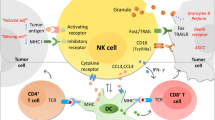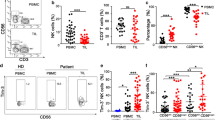Abstract
The natural killer (NK) activity of peripheral blood mononuclear cells and serum immunosuppressive acidic protein (IAP) levels were examined in patients with esophageal or gastric cancer, before and after surgery. Patients with stage IV esophageal or stage IV gastric cancer had significantly lower NK activity (39.5±14.8% and 37±11.6%, respectively), and also higher serum IAP levels (778±264 μg/mL and 633±156 μg/mL, respectively), than the corresponding control values (50±5.6% and 375±26 μg/mL, respectively). Patients with esophageal or gastric cancer who underwent curative resection had high NK activity (54.8±11.6% and 54.8±8.0%, respectively), and low IAP levels (471±116 μg/mL and 490±42 μg/mL, respectively), compared with those who underwent non-curative resection. Patients who underwent non-curative resection had lower NK activity and higher serum IAP levels than those who underwent curative resection, even 1 month after surgery. Mononuclear cells in the regional lymph nodes and tumor specimens showed significantly lower NK activity than those in the peripheral blood and spleen. Thus, NK activity and the IAP level reflected the immunocompetence, clinical course, and surgical curability of those patients. NK cells appeared not to have any significant antitumor activity in the regional lymph nodes or in the tumor itself, although they were still active in the peripheral blood.
Similar content being viewed by others
References
Talmadge JE, Meyers KM, Prieur DJ, Starkey JR (1980) Role of natural killer cells in tumor growth and metastasis: C57BL/6 normal and beige mice. J Natl Cancer Inst 65:929–935
Lukomska B, Olszewski WL, Engeset A, Kolstad P (1983) The effect of surgery and chemotherapy on blood NK cell activity in patients with ovarian cancer. Cancer 51:465–469
Tamura K, Shibata Y, Matsuda Y, Ishida N (1981) Isolation and characterization of an immunosuppressive acidic protein from ascitic fluid of cancer patients. Cancer Res 41:3244–3252
Tanaka N, Hashimoto T, Matsui T, Ohida J, Ono M, Orita K (1983) Natural cytotoxic reactivity of peripheral blood lymphocytes from digestive tract cancer patients against a colon cancer cell line and virus-infected Hela cells. Gann 74:419–425
Tsuji K, Abo S, Kudoo T, Hashimoto M, Kawamura Y (1985) A clinical study on natural killer activity in patients with esophageal cancer (in Japanese). Jpn J Gastroenterol Surg 18:8–14
Shimizu N, Yamane T, Karino T, Hamazoe R, Osaki Y, Kanayama H, Maeta M, Koga S (1983) Immunosuppressive acidic protein (IAP) in gastric cancer patients. Jpn J Surg 13:312–316
Shimizu N, Yamashiro H, Murakami A, Hamazoe R, Maeta M (1991) Diagnostic accuracy of combination of assays for immunosupressive acidic protein and carcinoembryonic antigen in detection of recurrence of gastric cancer. Eur J Cancer 27:190–193
Japanese Research Society for Gastric Cancer (1981) The general rules for the gastric cancer study in surgery and pathology. Jpn J Surg 11:127–139
Japanese Society for Esophageal Diseases (1976) Guidelines for the clinical and pathologic studies on carcinoma of the esophagus. Jpn J Surg 6:69–78
Svennevig JL, Closs O, Harboe M, Svaar H (1978) Characterization of lymphocytes isolated from non-lymphoid human malignant tumours. Scand J Immunol 7:487–493
Mancini G, Carbonara AP, Hermans JE (1965) Immunochemical quantitation of antigen by single radial immunodiffusion. Immunochemistry 2:234–254
Lanier LL, Phillips JH, Hackett J, Tutt M, Kurmar V (1986) Natural killer cells: Definition of a cell type rather than a function. J Immunol 137:2735–2739
Wiltrout RH, Herberman RB, Zhang SR, Chirigos MA, Ortaldo JR, Green KM, Talmadge JE (1985) Role of organ-associated NK cells in decreased formation of experimental metastases in lung and liver. J Immunol 134:4267–4275
Stewart LD, Ades EW (1984) Prospective study of natural cytotoxicity in peripheral blood of patients with nonlymphoid solid malignancies. Clin Immunol Immunopathol 31:78–86
Hersey P, Edwards A, McCarthy WH (1980) Tumor-related changes in natural killer activity in melanoma patients. Influence of stage of disease, tumor thickness, and age of patients. Int J Cancer 25:187–194
Sample WF, Gertner HR, Chretien PB (1971) Inhibition of phytohemagglutinin-induced in vitro lymphocyte transformation by serum from patients with carcinoma. J Natl Cancer Inst 46:1291–1297
Author information
Authors and Affiliations
Rights and permissions
About this article
Cite this article
Oka, M., Mitsunaga, H., Hazama, S. et al. Natural killer activity and serum immunosuppressive acidic protein levels in esophageal and gastric cancers. Surg Today 23, 669–674 (1993). https://doi.org/10.1007/BF00311703
Received:
Accepted:
Issue Date:
DOI: https://doi.org/10.1007/BF00311703




